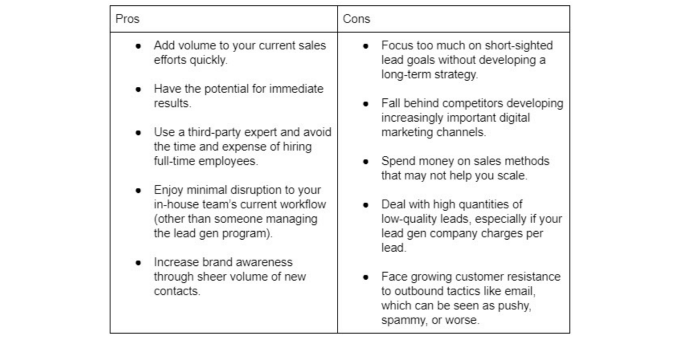When it comes to kicking up business leads, more and more B2B companies are realizing cold-calling and trade shows just aren’t cutting it anymore. The next step is to figure out what else you can do to gain more leads.
One possible option is to hire a lead generation company. But how do you evaluate if that approach is right for you? Before you leap into lead generation, you have to consider what your company needs from both a short- and a long-term perspective. Is using a lead gen company the best route?
To help you answer that, we’ll cover a number of important questions below, including these:
- How do lead gen companies work?
- What results do lead gen companies promise?
- What are the pros and cons of using a lead gen company?
- How much does it cost to use a lead gen company?
- How do your target customers really buy today?
Before you read more, here’s a quick video:
How do lead gen companies work?
Typically, lead generation companies wield two primary outbound marketing tactics: cold-calling and email marketing. The idea is that lead gen specialists can implement these tactics much more efficiently and effectively than your internal sales team.
Note that some lead gen companies may also use web content to drive people to landing pages that, for example, ask for an email address. But by and large, lead gen companies use cold-calling and email (often in the form of spam) to produce leads quickly and then hand those leads over to the client.
What results do lead gen companies promise?
Lead generation companies typically promise results such as:
- Enjoy a more streamlined, accelerated lead generation process
- Enable your sales team to spend more time building relationships rather than chasing leads
- Gain more high-quality leads that are ready to buy now (as opposed to leads who may be open to your business down the road)
- Expand your customer base and increase revenue
What are the pros and cons of using a lead gen company?
Whether a lead gen company is right for you requires careful consideration. Keeping these pros and cons in mind will help.

(Note: You may also want to consider lead gen apps that don’t necessarily involve hiring a lead gen company. HubSpot, for example, has compiled a long list of lead generation tools.)
How much does it cost to use a lead gen company?
That said, hiring a lead gen company can still be a hefty investment. Also, you’ll want to choose a company with a pricing model that’s right for your budget and your business needs.
Though models vary, pay-per-lead pricing and retainer-based pricing are the most common. The following numbers will give you a sense of just how much it costs to use a lead gen company:
- According to the DeTorres Group, the overall average cost per lead is $198.
- The same DeTorres Group research also shows leads vary by industry with, for example, industrial/manufacturing at $235, consumer products at $182, and non-profits at $43.
- Expandi, a LinkedIn automation software company who analyzed the lead gen pricing models of more than 100 agencies, reports that monthly retainer fees for a lead gen company can range widely, generally in a range of $3,000 to $20,000 per month.
(For more details on pricing, Expandi takes a deeper dive into the pricing models of five prominent lead gen companies.)
How do your target customers really buy today?
In your research on lead gen, you may also run into the term demand generation. What’s the difference? Basically, demand gen is intended to create brand awareness on the web. This is the kind of thing that happens at the top of the sales funnel, while lead gen happens closer to the bottom of the funnel.
In reality, treating these as two completely separate endeavors is a luxury that big companies with huge budgets may be able to afford.
But more importantly, if you’re a B2B company with complex products that are relatively costly, you have to understand the interconnectedness of generating both online brand awareness and quality leads given that:
- 49% of new B2B customer sales cycles take 1 to 6 months; 46% take 7 to 12 months
- 57% of customers are more than halfway through the purchase process before their first meaningful contact with the seller
- 80% of sales interactions will take place online by 2025
- 17% of the total purchase journey is spent by customers talking to potential suppliers
Numbers like these should give you pause. Just how valuable is a lead from a third party if that lead doesn’t even know who you are? And what if the lead is already in your competitors’ sales funnels? Can you easily jump into the mix?
Build a marketing approach to help people know you, like you, and trust you
An alternative to a lead gen company is working with a digital marketing agency to create compelling online content that serves as a “digital twin” of your sales team.
This B2B manufacturer, for example, found the lead gen option “far too expensive for a lot of unqualified leads.” On the other hand, they’ve had “phenomenal” results using our Digital Twin approach.
And it’s not hard to understand why: The well-established adage in sales is that people won’t do business with you unless they know you, like you, and trust you. With the Digital Twin approach, you’re following the same formula — only you’re using strategic online content.
This can play a pivotal role in generating quality leads for the long term. It also reflects the reality that your prospects are searching increasingly for answers online. And if you’re not there consistently providing the information, insights, and tools they’re looking for, you can bet your competitors are — or soon will be.

